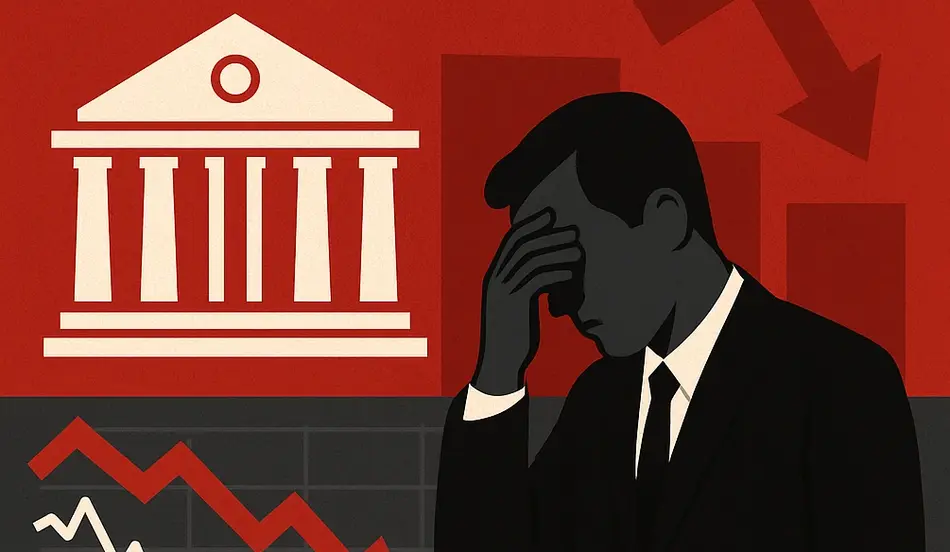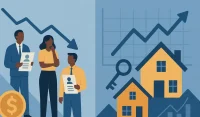The Unprecedented Market Moves That Signal Economic Crisis
Markets are rattled. Recent moves in short-term interest rate instruments suggest a level of volatility that typically accompanies major recessions—not routine adjustments. On Friday, trading saw 30-basis-point swings across key contracts, with term SOFR futures reacting at crisis levels. These are not normal fluctuations; they are signs of structural economic stress.
The volatility deepened over the weekend. Federal Reserve Board Governor Adriana Kugler resigned abruptly, just two years into her term. Appointed by President Biden in 2023, Kugler was a known hawk on interest rate policy. Her departure opens a vacancy that President Trump is expected to fill with a more dovish appointee—one likely to push for easier monetary policy.
Treasury bill auctions added fuel to the fire. Six-month notes cleared at 3.98%, sharply down from 4.12% last week. Three-month paper dropped to 4.165%, down from 4.23%. These moves reflect a market increasingly convinced that major interest rate cuts are on the horizon—possibly sooner than the Federal Reserve has publicly admitted.
The Economic Data That’s Forcing the Fed’s Hand
Behind the market movements lies hard data. The July jobs report showed weakness across multiple categories. While a single month of soft payroll numbers might normally be dismissed, this time it’s different: 73,000 new jobs were created—well below forecasts—and the unemployment rate rose to 4.2%.
More importantly, previous months were revised downward. These changes imply that economic deterioration began months earlier and is deeper than initially understood.
But it’s not just jobs. Consumer data is flashing red as well. Real personal consumption expenditures (PCE) fell for the first six months of 2025—the first such streak since August 2020. Even during the sluggish 2010s, six-month declines in real PCE were rare.
The Federal Reserve Bank of St. Louis published a report underscoring the seriousness of this shift. Consumer behavior, it argues, offers the clearest early warnings of economic slowdown. And what we’re seeing now is no minor dip—it’s a structural softening of household confidence and spending power.
Market Reactions to Policy Uncertainty
Derivative markets offer a crystal-clear view into investor sentiment. The term SOFR futures market has exploded in response to the current economic conditions:
- March 2026 contract: +31.5 basis points
- June 2026 contract: +30 basis points
- September 2026 contract: +27 basis points
These movements are enormous for instruments that usually swing by 10 to 15 basis points per day. The message is clear: markets expect aggressive monetary easing soon.
The yield curve adds another layer of confirmation. The spread between the 3-month and 6-month Treasury bills has steepened significantly—classic behavior ahead of large-scale interest rate cuts.
The last time this pattern emerged was in mid-2024. Back then, the Fed underestimated economic softening and kept policy tight for too long. The current situation looks even more precarious.
Looking to Hire Fast?
Hiring managers can now post jobs for free on WhatJobs and connect with millions of jobseekers.
The Federal Reserve’s Balancing Act
Publicly, Fed officials remain cautious. Cleveland Fed President Loretta Mester stated after the jobs report that the labor market still appears “healthy” and that inflation remains the key concern. But markets clearly aren’t buying it.
Behind closed doors, there’s growing consensus that economic weakness has overtaken inflation as the dominant risk. While public rhetoric remains focused on stability, the trading floors are already pricing in a full-blown policy reversal.
The discrepancy between Fed communications and market expectations is a dangerous one. If it continues, it could erode trust in the Fed’s ability to respond credibly to fast-changing conditions.
A Dangerous Feedback Loop
A shift in consumer psychology is one of the most dangerous developments in macroeconomics. Right now, that shift is underway. Fear of recession is causing households to cut spending, especially on discretionary goods and services.
This drop in demand further weakens the economy, reinforcing fears and triggering even deeper pullbacks in consumption. It’s a self-reinforcing loop, and breaking it will require forceful monetary intervention.
If the Federal Reserve waits too long, it risks allowing the loop to become entrenched—just as it did in 2008 and briefly in 2020.
International and Regulatory Implications
The ripple effects of this economic pivot are global. U.S. monetary policy plays an outsized role in shaping international capital flows, currency markets, and central bank policy abroad. A U.S. pivot toward lower rates could spark similar moves in the ECB, Bank of Japan, and Bank of England.
On the regulatory front, the Fed may need to reassess its capital and liquidity requirements for banks and financial institutions. Lower rates could encourage risk-taking, which would require countermeasures elsewhere in the financial system.
Rethinking Economic Policy Frameworks
There’s a deeper lesson in all this. The post-pandemic policy architecture—designed around inflation containment and labor market overheating—no longer fits the moment. The Fed may soon need to adopt a new model, one that places greater emphasis on demand-side weakness and consumer fragility.
That includes revisiting the Phillips Curve, updating inflation targets, and perhaps even considering a dual-mandate-plus framework that incorporates financial stability more explicitly into policy decisions.
For now, however, all eyes are on the next Federal Reserve interest rate decision. Markets are already two steps ahead—what remains to be seen is whether policymakers are willing to catch up.
Frequently Asked Questions
Q: What are the shocking Federal Reserve interest rate cuts economic weakness signals and why are they significant?
A: The shocking Federal Reserve interest rate cuts economic weakness signals refer to mounting evidence of economic deterioration that is forcing the Federal Reserve to consider major policy changes. These signals are significant because they indicate a fundamental shift in economic conditions that requires immediate policy response.
Q: How do the shocking Federal Reserve interest rate cuts economic weakness signals affect market expectations?
A: The shocking Federal Reserve interest rate cuts economic weakness signals have created unprecedented volatility in financial markets, particularly in interest rate derivatives. Markets are pricing in substantial rate cuts based on overwhelming evidence of economic deterioration.
Q: What are the broader implications of the shocking Federal Reserve interest rate cuts economic weakness scenario?
A: The shocking Federal Reserve interest rate cuts economic weakness scenario has implications for investment strategies, international economic relationships, and regulatory frameworks. It may require fundamental changes to how policymakers approach economic challenges.
Q: How can investors respond to the shocking Federal Reserve interest rate cuts economic weakness signals?
A: Investors should consider positioning for lower interest rates while remaining aware of the economic weakness that’s driving these expectations. This may involve adjusting fixed income allocations and considering the impact on equity valuations.




